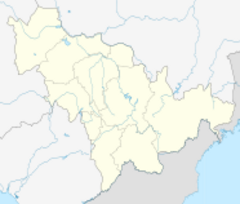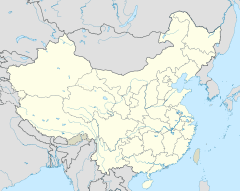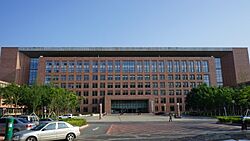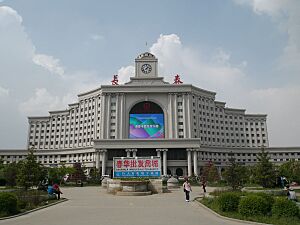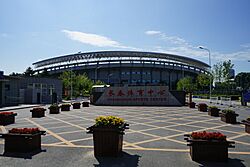Changchun facts for kids
Quick facts for kids
Changchun
长春市
|
|
|---|---|
|
Prefecture-level & Sub-provincial city
|
|

Clockwise from top: panoramic view from Shengtai Plaza, panoramic view of Ji Tower, Former Manchukuo State Department, Statue on cultural square, Changchun Christian Church, Soviet martyr monument.
|
|
| Nickname(s):
北国春城 (Spring City of the Northern Country)
|
|
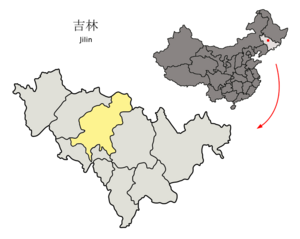
Location of Changchun City (yellow) in Jilin (light grey) and China
|
|
| Country | China |
| Province | Jilin |
| County-level divisions | 7 districts 2 county-level divisions 1 county |
| Incorporated (town) | 1889 |
| Incorporated (city) | 1932 |
| Municipal seat | Nanguan District |
| Government | |
| • Type | Sub-provincial city |
| • Body | Changchun Municipal People's Congress |
| Area | |
| • Prefecture-level & Sub-provincial city | 24,734 km2 (9,550 sq mi) |
| • Urban
(2017)
|
1,855.00 km2 (716.22 sq mi) |
| • Metro | 1,855.00 km2 (716.22 sq mi) |
| Elevation | 222 m (730 ft) |
| Population
(2020 census)
|
|
| • Prefecture-level & Sub-provincial city | 9,066,906 |
| • Density | 366.577/km2 (949.429/sq mi) |
| • Urban | 5,691,024 |
| • Urban density | 3,067.937/km2 (7,945.922/sq mi) |
| • Metro | 5,019,477 |
| • Metro density | 2,705.918/km2 (7,008.294/sq mi) |
| GDP | |
| • Prefecture-level & Sub-provincial city | CN¥ 553 billion US$ 88.8 billion |
| • Per capita | CN¥ 73,324 US$ 11,773 |
| Time zone | UTC+8 (China Standard) |
| Postal code |
130000
|
| Area code(s) | 0431 |
| ISO 3166 code | CN-JL-01 |
| License plate prefixes | 吉A |
| Website | www.changchun.gov.cn |
| Changchun | |||||||||||||||||||||||||||||||
|---|---|---|---|---|---|---|---|---|---|---|---|---|---|---|---|---|---|---|---|---|---|---|---|---|---|---|---|---|---|---|---|

"Changchun" in Simplified Chinese characters
|
|||||||||||||||||||||||||||||||
| Chinese name | |||||||||||||||||||||||||||||||
| Simplified Chinese | 长春 | ||||||||||||||||||||||||||||||
| Traditional Chinese | 長春 | ||||||||||||||||||||||||||||||
| Hanyu Pinyin | Chángchūn | ||||||||||||||||||||||||||||||
| Literal meaning | "Long Spring" | ||||||||||||||||||||||||||||||
|
|||||||||||||||||||||||||||||||
| Hsinking | |||||||||||||||||||||||||||||||
| Chinese | 新京 | ||||||||||||||||||||||||||||||
| Hanyu Pinyin | Xīnjīng | ||||||||||||||||||||||||||||||
| Literal meaning | New Capital | ||||||||||||||||||||||||||||||
|
|||||||||||||||||||||||||||||||
| Manchu name | |||||||||||||||||||||||||||||||
| Manchu script | ᠴᠠᠨᡤᠴᠣᠨ | ||||||||||||||||||||||||||||||
| Romanization | Cangcon | ||||||||||||||||||||||||||||||
Changchun is a big city in Jilin Province, China. It's the capital and largest city of the province. The city is located in the middle of the Songliao Plain. Its name means "long spring" in Chinese.
Changchun is a very important industrial city, especially known for making cars. People sometimes call it "China's Detroit" because of its big role in the car industry. It's also known as a "National Garden City" because it has lots of green spaces and parks.
The city is also a hub for science and learning. It's home to several major universities, including Jilin University and Northeast Normal University. These are some of China's most respected universities.
Contents
History of Changchun
How Changchun Began
Changchun started as a small trading post during the Qing dynasty. It was a place where people traded things like furs. In 1800, it was named "Changchun Ting."
Later, in the late 1700s, many farmers from crowded areas like Shandong and Hebei moved here. By 1889, the village grew big enough to become a city called "Changchun Fu."
The Railway Era
In 1898, Changchun got its first railway station. This was part of a railway line built by the Russian Empire. It connected Harbin to Lüshun.
After a war between Russia and Japan (1904–1905), Japan took control of the southern part of this railway. Changchun became a key meeting point between the Russian and Japanese railway lines. This meant trains from different countries met here.
Japan saw Changchun as a very important place. They started planning and building a modern city around the railway station. They spent a lot of money to make it a fancy city with good facilities. This plan aimed to make Changchun a center for Japan's control over Manchuria.
The city's design was very modern for its time. It had wide roads and special areas for homes, shops, and factories. This planning helped Changchun grow quickly.
Hsinking: The New Capital
In 1932, Changchun was chosen as the capital of Manchukuo. This was a state controlled by Imperial Japan in Manchuria. The city was renamed Hsinking, which means "New Capital" in Japanese.
During this time, Hsinking became a very well-planned city. It had wide avenues and modern public buildings. Many of these buildings are still standing today. The city grew very fast in terms of its economy and buildings. It was designed with lots of trees and green spaces, earning it the nickname the Forest Capital.
The population of Hsinking also grew a lot. By 1944, it was one of the biggest cities in Manchukuo.
After World War II
In 1945, the Soviet Red Army took control of Changchun. The city went back to its original name. Later, during the Chinese Civil War, the city was taken by the Chinese Communist Party in 1948 after a long fight. This event was a big turning point in the war.
After the People's Republic of China was founded in 1949, Changchun became the capital of Jilin Province in 1954.
Changchun also became a major center for China's automotive industry. The First Automobile Works (FAW) started building trucks in 1956. They also made the famous Hongqi (Red Flag) limousines. This is why Changchun is known as "China's Detroit."
The city also became famous for its film industry. The Changchun Film Studio is one of China's oldest film studios. The city hosts the yearly Changchun Film Festival.
In 2007, Changchun hosted the 2007 Winter Asian Games, a big sports event.
Geography and Climate
Location and Landscape
Changchun is located in the middle of the Northeast China Plain. The city is at a moderate height, usually between 250 and 350 meters above sea level. There are 222 rivers and lakes in the area. The Yitong River flows through the city.
Weather in Changchun
Changchun has four distinct seasons. Winters are long, cold, and dry, lasting from November to March. Summers are hot and humid, from June to August. Spring and autumn are short. Snowfall is usually light in winter. The city gets a lot of sunshine throughout the year.
| Climate data for Changchun (1991–2020 normals, extremes 1951–2018) | |||||||||||||
|---|---|---|---|---|---|---|---|---|---|---|---|---|---|
| Month | Jan | Feb | Mar | Apr | May | Jun | Jul | Aug | Sep | Oct | Nov | Dec | Year |
| Record high °C (°F) | 4.6 (40.3) |
14.5 (58.1) |
23.4 (74.1) |
31.9 (89.4) |
35.2 (95.4) |
36.7 (98.1) |
38.0 (100.4) |
35.6 (96.1) |
30.6 (87.1) |
27.8 (82.0) |
20.7 (69.3) |
11.7 (53.1) |
38.0 (100.4) |
| Mean daily maximum °C (°F) | −9.3 (15.3) |
−3.9 (25.0) |
4.5 (40.1) |
14.8 (58.6) |
22.0 (71.6) |
26.5 (79.7) |
28.1 (82.6) |
26.9 (80.4) |
22.3 (72.1) |
13.7 (56.7) |
2.0 (35.6) |
−7.1 (19.2) |
11.7 (53.1) |
| Daily mean °C (°F) | −14.3 (6.3) |
−9.3 (15.3) |
−1 (30) |
8.8 (47.8) |
16.2 (61.2) |
21.3 (70.3) |
23.7 (74.7) |
22.3 (72.1) |
16.5 (61.7) |
7.9 (46.2) |
−2.8 (27.0) |
−11.8 (10.8) |
6.5 (43.6) |
| Mean daily minimum °C (°F) | −18.6 (−1.5) |
−14.3 (6.3) |
−6.1 (21.0) |
3.0 (37.4) |
10.5 (50.9) |
16.3 (61.3) |
19.7 (67.5) |
18.2 (64.8) |
11.2 (52.2) |
2.8 (37.0) |
−7.1 (19.2) |
−15.9 (3.4) |
1.6 (35.0) |
| Record low °C (°F) | −36.5 (−33.7) |
−31.9 (−25.4) |
−27.7 (−17.9) |
−12.2 (10.0) |
−3.4 (25.9) |
4.5 (40.1) |
11.1 (52.0) |
3.9 (39.0) |
−3.7 (25.3) |
−13.4 (7.9) |
−24.7 (−12.5) |
−33.2 (−27.8) |
−36.5 (−33.7) |
| Average precipitation mm (inches) | 4.4 (0.17) |
6.1 (0.24) |
13.4 (0.53) |
22.0 (0.87) |
62.6 (2.46) |
102.1 (4.02) |
147.5 (5.81) |
131.6 (5.18) |
53.9 (2.12) |
24.6 (0.97) |
16.9 (0.67) |
8.2 (0.32) |
593.3 (23.36) |
| Average precipitation days (≥ 0.1 mm) | 5.1 | 4.4 | 5.6 | 6.5 | 11.0 | 13.5 | 13.4 | 12.3 | 8.1 | 6.8 | 6.1 | 6.5 | 99.3 |
| Average snowy days | 7.5 | 5.9 | 6.4 | 2.4 | 0.1 | 0 | 0 | 0 | 0 | 1.9 | 6.1 | 8.2 | 38.5 |
| Average relative humidity (%) | 66 | 57 | 51 | 44 | 50 | 63 | 75 | 76 | 65 | 59 | 62 | 67 | 61 |
| Mean monthly sunshine hours | 180.9 | 203.7 | 236.9 | 238.1 | 253.5 | 245.4 | 229.0 | 235.3 | 236.8 | 210.4 | 167.7 | 159.1 | 2,596.8 |
| Percent possible sunshine | 62 | 69 | 64 | 59 | 55 | 53 | 49 | 55 | 64 | 62 | 59 | 58 | 59 |
| Average ultraviolet index | 1 | 2 | 3 | 5 | 6 | 7 | 8 | 8 | 5 | 3 | 1 | 1 | 4 |
| Source 1: China Meteorological Administration Weather China | |||||||||||||
| Source 2: Weather Atlas | |||||||||||||
City Layout and Divisions
Changchun is divided into different areas. It has 7 districts, 3 county-level cities, and 1 county. These divisions help manage the large city and its surrounding areas.
| Map | |||||||||
|---|---|---|---|---|---|---|---|---|---|
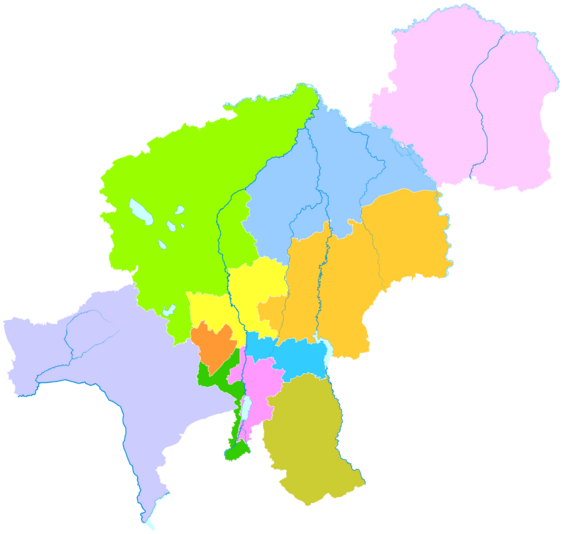
Nanguan
Kuancheng
Chaoyang
Erdao
Luyuan
Shuangyang
Jiutai
Nong'an
County Yushu
(city) Dehui
(city) Gongzhuling
(city) |
|||||||||
| Name | Simplified Chinese | Hanyu Pinyin | Population (2020 census) | Area (km2) | |||||
| City proper | |||||||||
| Chaoyang District | 朝阳区 | Cháoyáng Qū | 1,074,628 | 286.7 | |||||
| Nanguan District | 南关区 | Nánguān Qū | 1,066,422 | 529.7 | |||||
| Kuancheng District | 宽城区 | Kuānchéng Qū | 856,177 | 941.5 | |||||
| Erdao District | 二道区 | Èrdào Qū | 559,966 | 452 | |||||
| Luyuan District | 绿园区 | Lùyuán Qū | 1.002,672 | 492.6 | |||||
| Suburb | |||||||||
| Shuangyang District | 双阳区 | Shuāngyáng Qū | 335,723 | 1,677 | |||||
| Jiutai District | 九台区 | Jiǔtái Qū | 613,836 | 3368 | |||||
| Satellite cities | |||||||||
| Dehui | 德惠市 | Déhuì Shì | 635,476 | 2,984 | |||||
| Yushu | 榆树市 | Yúshù Shì | 836,098 | 4,749 | |||||
| Gongzhuling | 公主岭市 | Gōngzhǔlǐng Shì | 862,313 | 4,145 | |||||
| Rural | |||||||||
| Nong'an County | 农安县 | Nóng'ān Xiàn | 763,983 | 5,239 | |||||
People of Changchun
Population Growth
Changchun is a very populated city. In 2020, over 9 million people lived in the area it controls. The city's main urban area had about 5 million people.
| Historical population | ||
|---|---|---|
| Year | Pop. | ±% |
| 1932 | 104,305 | — |
| 1934 | 160,381 | +53.8% |
| 1939 | 415,473 | +159.1% |
| 1944 | 863,607 | +107.9% |
| 1953 | 855,197 | −1.0% |
| 1964 | 4,221,445 | +393.6% |
| 1982 | 5,744,769 | +36.1% |
| 1990 | 6,421,956 | +11.8% |
| 2000 | 7,135,439 | +11.1% |
| 2010 | 7,677,089 | +7.6% |
| Population size may be affected by changes in administrative divisions. In 1958, 5 counties were put under Changchun's jurisdiction, increasing the total population to over 4 million. | ||
Different Groups of People
Most people in Changchun are Han nationality, which is the main ethnic group in China. But there are also several other minority groups living here. These include the Manchu, Korean, Hui, and Mongol people.
| Ethnicity | Population | Percentage |
|---|---|---|
| Han | 6,883,310 | 96.47% |
| Manchu | 142,998 | 2.0% |
| Korean | 49,588 | 0.69% |
| Hui | 43,692 | 0.61% |
| Mongol | 11,106 | 0.16% |
| Xibe | 685 | 0.01% |
| Zhuang | 533 | 0.01% |
| Miao | 522 | 0.01% |
| Other | 3,005 | 0.04% |
Culture and Beliefs
Local Language
The most common way of speaking in Changchun is the Northeastern Mandarin dialect. This dialect is a mix of languages from people who moved here from other parts of China. In the city, the dialect is closer to standard Mandarin Chinese.
Religions in Changchun
Changchun has four main religions: Buddhism, Taoism, Christianity, and Islam. There are many places of worship for these religions.
Some famous temples and churches include Changchun Wanshou Temple, Baoguo Prajna Temple, and Changchun Catholic Church. Long ago, many Manchu people believed in Shamanism. Today, the study of Shamanism is an important part of the region's culture.
Places to Visit
- Jilin Provincial Museum: This is a top museum in China. It has many interesting collections about the region's history and culture.
- Badabu: This is a group of old government buildings from the Manchukuo period. They have a unique mix of Chinese, Japanese, and Manchurian styles.
- Jingyuetan National Forest Park: Located outside the city, this park is a beautiful place to visit. It's one of China's top tourist spots and hosts the annual Vasaloppet China ski event.
Economy and Industries
Changchun's economy is strong and growing. In 2010, its total economic output was about 332.9 billion Chinese Yuan.
Main Industries
Changchun is famous for several key industries:
- Automobiles: This is the biggest industry. Changchun is China's largest center for making and designing cars. The FAW Group is based here. They made China's first truck and car. They also work with big international brands like Audi, Volkswagen, and Toyota.
- Transportation Manufacturing: The city also makes trains and other transport vehicles. Changchun Railway Vehicles builds many of China's passenger trains and even bullet train carriages. These new bullet trains can run in very cold weather and have cool features like Wi-Fi and sleeper beds.
- Other Industries: These include processing farm products, making medicines, photo electronics, and building materials.
Development Zones
Changchun has special areas called development zones. These zones help new businesses grow and bring in money from other countries.
- Changchun Automotive Economic Trade and Development Zone: This zone focuses on the car industry. It has a huge wholesale center for cars and car parts.
- Changchun High Technology Development Zone: This zone is for advanced technology. It has many universities and research centers. It focuses on bio-engineering, car engineering, new materials, and information technology.
- Changchun Economic and Technological Development Zone: This zone attracts foreign companies. It focuses on car parts, photo electronics, medicines, and food processing.
City Infrastructure
Changchun is a well-planned city with wide roads and public spaces. The city is always growing and improving its transport systems.
Trains
Changchun has two main train stations. The central Changchun railway station connects to many cities in China. The new Changchun West railway station is mainly for high-speed trains.
Buses and Trams
The city has a large bus system with over 250 routes. Changchun is also one of the few cities in China that still has a historic tram system. It opened in 1941 and now has one main line, plus a new branch to the West Railway Station.
Metro System
Changchun has a modern metro system called Changchun Rail Transit. It includes both light rail and metro lines. The first line opened in 2002. By 2018, there were 5 lines, covering over 100 kilometers. More lines are being built to make travel around the city even easier.
Roads and Highways
Changchun is connected to China's national highway network. Major expressways link it to cities like Beijing, Harbin, and Shenzhen. The road between Changchun and Jilin City is especially busy.
Airport
Changchun Longjia International Airport is located northeast of the city. It opened in 2005 and serves both Changchun and Jilin City. The airport has flights to many major cities in China and some international destinations like Bangkok and Tokyo.
Education in Changchun
Universities and Colleges
Changchun is a big center for higher education. It has 27 universities and colleges with about 160,000 students.
- Jilin University: One of the largest universities in China with over 60,000 students.
- Northeast Normal University: Another key university in China.
- Other universities include Changchun Normal University, Changchun University, and Changchun University of Science and Technology.
Schools
Changchun has many middle schools and international schools.
- High School Attached to Northeast Normal University
- Affiliated Middle School to Jilin University
- Changchun American International School
- Deutsche Internationale Schule Changchun
Sports and Entertainment
Changchun is home to professional sports teams:
- Jilin Northeast Tigers: A basketball team that plays in China's top league.
- Changchun Yatai: A soccer team that won the Chinese Super League in 2007.
The city has several large sports venues, including the Changchun City Stadium and the Development Area Stadium. The Changchun Wuhuan Gymnasium was the main venue for the 2007 Asian Winter Games.
Changchun also has an indoor speed skating rink, which is one of only five in China.
Film Industry
- Changchun Film Group Corporation: A major film company.
- Changchun Film Festival: An annual event celebrating movies.
Famous People from Changchun
- Ei-ichi Negishi: Won the Nobel Prize in Chemistry in 2010.
- Liu Xiaobo: Won the Nobel Peace Prize in 2010.
Sister Cities
Changchun has friendly relationships with many cities around the world. These are called "sister cities" or "twin towns."
 Nuuk, Greenland
Nuuk, Greenland Sendai, Japan
Sendai, Japan Ulsan, South Korea
Ulsan, South Korea Flint, United States
Flint, United States Little Rock, United States
Little Rock, United States Windsor, Canada
Windsor, Canada Ulan-Ude, Russia
Ulan-Ude, Russia Minsk, Belarus
Minsk, Belarus Chongjin, North Korea
Chongjin, North Korea Birmingham, United Kingdom
Birmingham, United Kingdom Wolfsburg, Germany
Wolfsburg, Germany Žilina, Slovakia
Žilina, Slovakia Novi Sad, Serbia
Novi Sad, Serbia Masterton, New Zealand
Masterton, New Zealand
Images for kids
See also
 In Spanish: Changchun para niños
In Spanish: Changchun para niños


